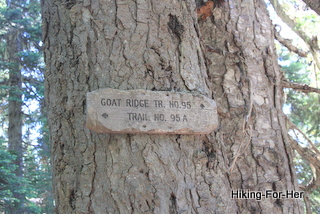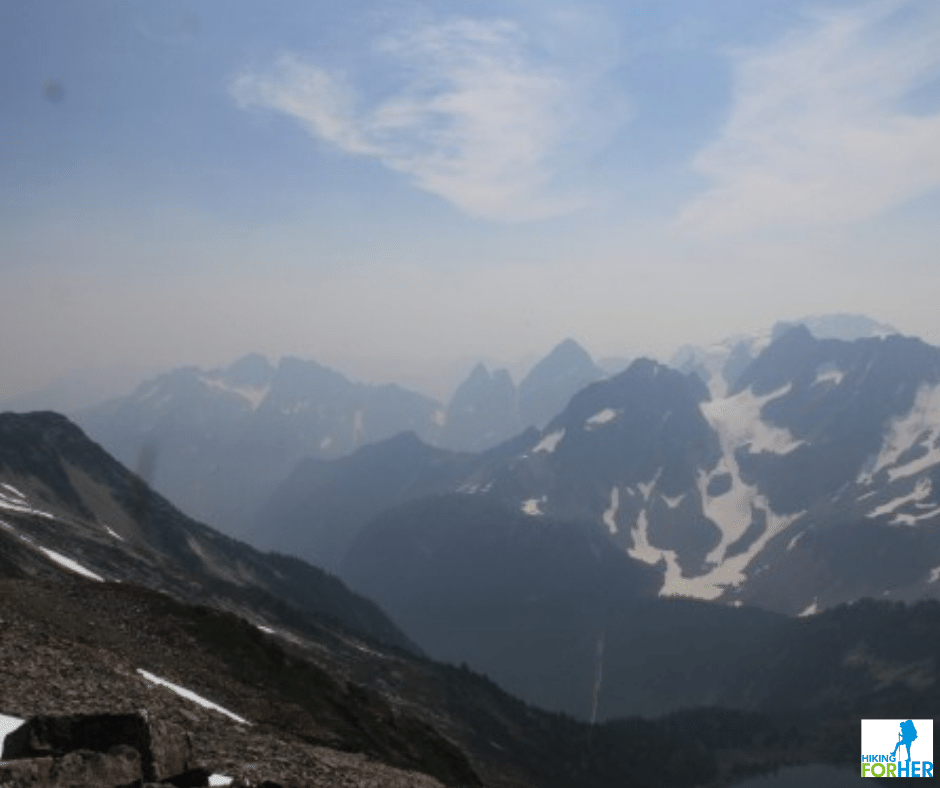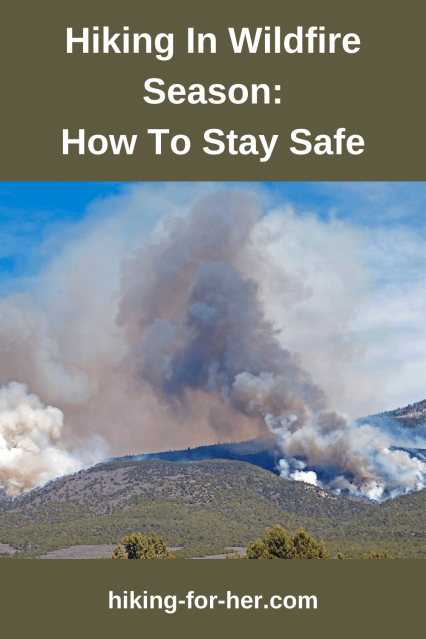
Hiking In Wildfire Season:
Be Prepared To Stay Safe
By Diane Spicer
If you're here for tips on hiking in wildfire season, you've already noticed that wildfires are growing larger, more common, start earlier and last longer during the summer hiking season.
If you haven't been keeping close track of how bad things have gotten in the U.S., here is a little background reading:
- This is an article on the early start to the 2022 wildfire season in the southwest.
- And another on the Marshall Fire in early 2022.
What can you do to stay safe
while hiking in wildfire season?
The thought of hiking in wildfire season is becoming a pressing concern for hikers throughout the United States.
How can you have a safe hiking fire season?
What can you do to take good care of your health and safety during wildfire season?
I've gathered some resources and tips together to make hiking during fire season easier for you.
Jump down to what interests you most, or keep reading for all the details on hiking in wildfire season
Go armed with knowledge
You'll need long range information (months ahead of your hiking), plus in depth knowledge of current conditions, to stay safe hiking in wildfire season.
That's a given.
So here's how to get that knowledge.
Use predictions and modeling to avoid wildfires as a hiker
Read this free pdf annual 2021 report from the National Interagency Coordination Center on Wildland Fire Summary and Statistics.
It goes into detail on where, and when, wildfires occurred in the United States.
The maps and tables are eye opening, to say the least.
Sit down with it to get a feel for the chances of a fire where you're planning to hike and backpack.
Be clear eyed and pass on fire prone areas for the upcoming season.
Another thing to do way ahead of time: use predictive modeling from the National Interagency Fire Center to choose a good hiking window.
- This free pdf is organized by monthly seasonal outlook by regions.
More knowledge you need to stay safe while hiking in wildfire season
Once you zero in on a hiking trail or camping area, know the current rules. There is no excuse for not doing this, full stop.
Find answers to these questions:
Is the forest or park I'm headed to experiencing closures?
- Check the website for updated information or red flag warnings.
Where can I get off the trail in a hurry if I need to?
- Pour over maps for not only great hiking trails and camping spots, but for public and private road access that will lead you to safety.
Are camp fires allowed?
- If they are, read these Leave No Trace guidelines for how to minimize their impacts.
- Know how to put out a fire completely before you walk away.
If no fires, what are some campfire alternatives?
If you're traveling to an area and plan on using a stove that needs fuel, ask yourself:
- Can I transport the fuel myself? (If planning on air travel, the answer is NO.)
- Where can I find local supplies of fuel?
- How will I dispose of or recycle my used canisters or cartridges?
- What type of backpacking stove is best?
Stay connected to stay current
The good old days of disappearing for weeks at a time during the height of summer are gone.
Sad but true fact.
To stay safe, you'll have to check in and get updates for your area every day when you're in fire prone areas.
- Fires can start quickly and spread rapidly, so thinking "Day 1 no fires, all good" may not hold true throughout your hiking trip.
Do you have a communication strategy for the outside world that does not involve cell phone coverage?
Here are a few resources for updates, and I'll add more as I find and evaluate them.
Local weather conditions
Bookmark the National Weather Service page for your targeted area.
They have a special fire weather page here.
- These professionals issue public safety warnings, and you need to read and heed them if you're hiking in wildfire season (or any season, see safe hiking weather tips here).
Check this fire and smoke U.S. and Canadian map, updated daily.
- Use this information to gather important information on current air quality, road closures due to fires, and predicted wind directions.
Go more granular for wildfire information by searching for state agencies that monitor these events.
Start with InciWeb, which maps current prescribed and wild fires across the U.S. You can drill down to the fire you're interested in, and follow its progression.
Also do a search by state for real time updates from local officials and media (with caution, since sensationalized stories sell).
Then check this real time air quality monitoring website which is color coded green, orange, red.
Now for the pivotal question.
Should you go hiking in wildfire season?
There are a lot of variables embedded within that question.
Let's start with some changes in behavior that you can adopt if you are concerned about hiking in wildfire season.
Hike early in the season to reduce risk
Every month you wait to go backpacking or day hiking, conditions get drier and more combustible.
So move up your plans into late spring and early summer.
But you will have to address early season concerns like a deep snowpack, raging stream crossings, and soggy trails.
Determine what means more to you:
getting out there and having fun, or taking a chance on late(r) season hiking with the possibility of canceling plans.
Should you go into a fire prone or active area?
Should you start a backpacking trip when you already know a fire is burning in or near the area you want to hike through?
To get a sense of your personal risk tolerance, ask yourself:
- Can you handle a curveball mid-trip that blows up your careful plans?
- Are you a good decision maker under pressure?
- Would being anywhere near a wildfire on a (not yet closed) trail rattle your nerves? How would you handle the anxiety?
- Do you have underlying health conditions (lungs, heart, diabetes, etc. ) that smoky air and ash would exacerbate?
Add up all the risks you're willing to take.
Balance them with the deal breaker risks.
And you already know this, but here it comes:
- Always have a Plan B, even if you go forward with your first plan.
One way to mitigate risk is to purchase travel insurance so you can interrupt or change your travel plans without penalty.
Also, check your medical coverage. Is evacuation part of your policy? If not, add it to your travel insurance.
Remain flexible
It's tough to cancel or reschedule a trip you've been looking forward to for months.
Even tougher: to scramble to relocate to a nearby but safe(r) area.
I've had to do all of the above, and it left huge feelings of disappointment behind.
Hate to say it, but "better safe than sorry".
Food for thought
If you're faced with any of these decisions (abort, divert, delay or reschedule) due to wildfire in the area you're headed into, some pertinent questions:
How
likely is it for this area to be closed in the near future, including
road access?
- Use the resources above to gather data and get a feel for how local officials are talking about the possibility of closures.
- Can you "get in quick and get out fast", or is the area served by only one access point?
- Can you wait around until conditions improve or the fire is contained?
What is the current air quality? What is the weather forecast (precipitation, wind direction)?
- How will those two intersect during my trip?
What is my plan if a fire explodes or jumps a line into my area?
- This includes knowing each and every road, both public and private, in the area.
- It also means following wind speed and direction, which you can do on Windy.
What are my chances of rescue if I get trapped?
- If you're headed into a remote area, the chances go down compared with front country areas.
Who back home can I trust to help me track daily conditions and receive/relay my changing location information?
- Have them note changes, in writing and dated, in the itinerary you left behind. This information may become important in ways you can't predict.
 Be willing to change plans when fire weather threatens your hike.
Be willing to change plans when fire weather threatens your hike.
Don't be part of the wildfire problem
I'm not going to sugar coat this.
You know road access points (see above), so do one of these things when you get news of an uncontrolled or escalating fire close to you:
Option A: Turn around to get to a road quickly. Call ahead if possible to arrange transportation.
Option B: Keep hiking to get off the trail as soon as possible.
If there's a trail or park closure, respect it. If you press onward in the face of a fire, you endanger other lives, too.
And if you're hiking through a burned area, be aware of falling tree dangers.
What to do if you're in an active burn area?
The question is something you should contemplate before you're in this situation:
What will you do if you're caught in an area of smoke or active fire?
These tips from the Pacific Crest Trail Association are going to save your life.
These tips from Leave No Trace help you decide what to do when you see smoke.
NOLS provides tips in the article Managing Risk Outdoors: Backcountry Wildfires.
Funny thing about a trail.
It'll just lay there and wait for you until next year.
What to do when you're exposed to smoke when hiking
 Yikes! Lots of smoke surrounding the trail today, thanks to a nearby wildfire
Yikes! Lots of smoke surrounding the trail today, thanks to a nearby wildfireAs you hike in smoky air, you pull particulates and toxins into your lungs and therefore into your bloodstream.
Even when the fire is hundreds of miles away, the particulates linger in the air until you suck them into your body with your deep breathing.
Precautions you can take while hiking in wildfire season:
- Hydrate yourself fiercely. Moist nasal and mouth mucous membranes will trap larger smoke particles, while hydrated internal lung linings will help resident white blood cells (alveolar macrophages) mop up the rest.
- Include foods high in antioxidants in your backpacking and dayhiking meals while hiking in wildfire season. Here are my tips.
- Rest frequently and don't push hard for mileage unless it's important to get to a bailout point.
- Wear a mask (see recommendation below).
Hiking gear to add to your backpack during wildfire season
Add these safety and self care items to your gear checklist and have them handy while hiking in wildfire season:
- Technology that allows you to check in and get updates hourly if needed, such as satellite messengers. Be sure your subscription is activated and your battery power is up to the job.
- A short list of primary contact names with phone numbers and email addresses, in a ziplock bag (not just on your phone).
- N95 masks, the good ones like these, to protect your lungs from particulates.
- A bandanna to soak and use to remove soot and ash from your face or tie around your forehead or neck.
- A natural saline nose spray like this one, and eye drops. Don't make your own, as the risk of contamination is high.
Hiking in wildfire season: your informed choice
It's up to you whether or not you venture out into this new landscape haunted by fire.
Living in the Pacific Northwest, I've resigned myself to the fact that August will bring hazy skies, the smell of smoke, hazardous air quality, and both trail and road closures.
So I've moved up my plans and learned to deal safely with early summer conditions.
"Adapt" is the route I've decided to take.
What will you do?
My hope is that you'll use the resources on this page to continue hiking in wildfire season, but in a safe and purposeful way to keep yourself and others out of harms way.
Hiking in wildfire season, just one more wrinkle in the fabric of being a smart and safe hiker!
How to make sense of our new
hiking reality during fire season
Read this book: Fire Weather: On the Front Lines of a Burning World by John Vaillant.
Home page > Best Healthy Hiking Tips >
Hiking In Wildfire Season: Best Tips For Safety
|
I get emails all the time about what I wear, eat, carry and love to use on the trail. That's
why I provide affiliate links to you: the best gear that I use myself and have seen used by other hikers is instantly
available for your consideration, and the gear company sends a few
pennies per dollar to this reader-supported hiking website. There is no added cost to you! Everyone ends up a winner: Great gear for you, strong gear companies, and more free hiking tips for everyone. Thanks very much for your support. It's warmly and sincerely appreciated. It also helps send these hiking tips to all your virtual trail buddies around the globe. |
 |


